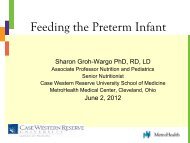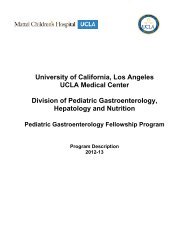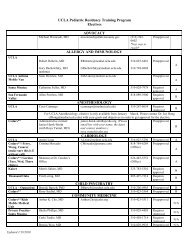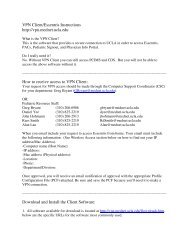Persistent Pulmonary Hypertension of the Newborn - Mattel ...
Persistent Pulmonary Hypertension of the Newborn - Mattel ...
Persistent Pulmonary Hypertension of the Newborn - Mattel ...
You also want an ePaper? Increase the reach of your titles
YUMPU automatically turns print PDFs into web optimized ePapers that Google loves.
It is 4 AM in <strong>the</strong> morning -------You attend <strong>the</strong> delivery <strong>of</strong> M.L. at 40 weeks’ gestation. He iscovered with thick meconium. Endotracheal suctioning producesthick meconium from <strong>the</strong> trachea.‣The infant receives assisted ventilation and surfactant‣Inhaled nitric oxide is started at an OI <strong>of</strong> 15‣Echocardiogram on DOL 2 shows severe pulmonaryhypertension (PPHN)‣Cranial sonography shows parenchymal blood‣The OI is now 40WHAT ARE YOU GOING TO DO?
Beyond “NO” – Yes, Yes, Yes ---• PDE inhibitors – Sildenafil, Milrinone• ET receptor antagonists - Bosentan• Vasodilator Prostaglandins – PGI 2 , PGE 1• Magnesium sulfate• NO precursor – L-arginine, Citrulline• Free radical scavenger – superoxide dismutase• Rho-kinase antagonists
Off Label Drug Use• FDA regulates labeling <strong>of</strong> drugs; it does notregulate use <strong>of</strong> drugs by physicians• Off-label drug use• may benefit individual patients• is not improper, illegal or contraindicated• does not require an IND• is not research & does not require consent• Reluctance <strong>of</strong> <strong>of</strong>f-label may deprive patients <strong>of</strong>potentially effective treatmentAAP, 2002
Off Label Drug Use• Off-label use <strong>of</strong> a drug should be:• based on sound evidence, expert medical judgment• done in good faith, in <strong>the</strong> best interest <strong>of</strong> <strong>the</strong> patient• discussed with <strong>the</strong> patient or parents• FDA encourages:• Publication <strong>of</strong> experience with <strong>of</strong>f-label use <strong>of</strong> drugs• Report adverse events
Off Label Drug Use• New uses, doses, or indications will not beapproved by <strong>the</strong> FDA until substantial evidence<strong>of</strong> safety and effectiveness – years, never??• Ethical & safety challenges• Neonates are constantly undergoing maturation –alter pharmacokinetics & end-organ responses• Therefore, clinical trials in adults or older childrencannot predict pharmacokinetics & end-organresponses <strong>of</strong> neonates
Off Label Drug Use• Should we accept <strong>of</strong>f-label drug use without fullknowledge <strong>of</strong> safety, pharmacokinetics, orefficacy and risk <strong>the</strong>rapeutic misadventures?
Post-INO Era• Questionnaire to220 neonatologistsin Canada,Australia, NewZealand• High Likelihood<strong>of</strong> using o<strong>the</strong>rtreatments forPPHNShivananda, 2012
Beyond NOToxic MoleculeLife Threatening Effects <strong>of</strong>Discontinuing INOLack <strong>of</strong> Availability <strong>of</strong> INO &/ ECMODe-regionalized neonatal careResource poor countries↓eNOS↑ETLack <strong>of</strong> Response in 30-40%Not possible to predict responseInitial response is not a guarantee <strong>of</strong>sustained responseALTERNATIVES ???Cost <strong>of</strong> INO is Exorbitant$10,142 initial charge, $10,142/day,max $25,000 per patient
Regulation <strong>of</strong> <strong>Pulmonary</strong> Vascular ToneBenza,2007
SELECTIVITYNO – Molecule <strong>of</strong> <strong>the</strong> 1990’sIMPACTNeonatal Respiratory ECLS casesNo effect on mortality
Regulation <strong>of</strong> <strong>Pulmonary</strong> Vascular ToneSILDENAFILDipyridamoleZaprinastPentoxyfylline
Sildenafil for <strong>Pulmonary</strong><strong>Hypertension</strong> inNeonatesShah, 2011
PO Sildenafil• 1 st dose - 1 mg/0.5 ml/kg per OGT• Dosing every 6 hours• Double dose if OI did not improve & BPstable after previous doseBaquero, 2006
Intravenous Sildenafil in PPHNSteinhorn, 2009
PDE-5 5 Inhibitor - Sildenafil• RCT to determine role <strong>of</strong> sildenafil in management <strong>of</strong>PPHNDrug Sponsor NCT# Start Completion N Centers TypeInhaled Iloprost University <strong>of</strong> Chicago NCT00409526 12/2006 06/2009 40 2 PilotMilrinone CHOP NCT01088997 06/2010 03/2012 18 3 (US) PKSildenafil (iv) Pfizer NCT01069861 12/2010 04/2013 40 1 (UK) Phase 2Sildenafil (po)Third Military MedicalUniversity, ChinaNCT01373749 03/2011 03/2011 40 2 Phase 3Sildenafil (iv) NHLBI NCT01409031 06/2011 06/2012 50 7 (US) Phase 2Inhaled PGE1 NICHD NCT00598429 09/2011 05/2012 50 9 Phase 2Sildenafil (po)Hamad MedicalCorporation, QatarNCT01558466 11/2011 11/2015 1001 (Qatar) Phase 3Bosentan Actelion NCT01389856 12/2011 08/2013 30 17 Phase 3
PDE5 Inhibitor - Sildenafil• In PPHN, sildenafil may:• facilitate weaning from INO• Decreases duration <strong>of</strong> mechanical ventilation,hospital stay• Sildenafil in combination with:• INO did not result in significant ↓ in systemic BP & actuallyimproved oxygenation• Milrinone (n=10) was not associated with hypotension oro<strong>the</strong>r adverse events
PDE-5 5 Inhibitor - Sildenafil• Potential AEs• delayed gastric emptying• hypotension• PDE6 inhibition - retinaldamage• Severe ROP - one PTinfant• Adults- CNS effects –emotional, psychologicaldisturbances, amnesia,loss <strong>of</strong> consciousness,aggressive behavior, ICH
Regulation <strong>of</strong> <strong>Pulmonary</strong> Vascular Tone, 3MILRINONE, 3
PDE-3 3 Inhibitor - Milrinone• Primary physiological disturbance in PPHN →↑RV afterload• Traditionally, physicians reluctant to treat PPHNwith afterload-reducing reducing agents because <strong>of</strong>concerns <strong>of</strong> systemic hypotension & desire tomaintain supranormal systemic BP• very high-dose vasopressors• dopamine or epinephrine may exacerbate PPHN• tachycardia, ↑ increasing myocardial O2 demand,McNamara, 2006, J Crit Care
Increased PDE3 activity in resistance PA after birthPDE-3 3 Inhibitor -MilrinoneMilrinone ↓ PVR and PAP in:•experimental models•adults•neonates- post cardiacsurgeryMilrinone inhibits NE-induced constriction inresistance PA from 1dSB and 100% O 2+iNO lambsChen, 2009
Milrinone Improves Oxygenationin Neonates With SeverePPHN• Routes <strong>of</strong> administration reported - IV, inhalation• Potential AEs:• Hypotension, thrombocytopenia, intra-cranial bleedMcNamara, 2006, J Crit Care
2005,Danhaive2006,Bassler,Kirpalani2006,McNamara2010,TziallaPDE-3 3 Inhibitor - MilrinoneType <strong>of</strong>StudyCaseseriesCaseseriesCaseseriesCasereportDiseasePPHNPPHNPPHNPPHNrefractory toINOSubjectsIUGR
Regulation <strong>of</strong> <strong>Pulmonary</strong> Vascular ToneBOSENTANEndo<strong>the</strong>lin system in vascular tissueET−1=endo<strong>the</strong>lin−1,BIG–ET−1=proendo<strong>the</strong>lin−1, ECE=endo<strong>the</strong>lin–converting enzyme,NO=nitric oxide, PGI 2 =prostacyclin
Endo<strong>the</strong>lin PathwayppET-1ET-AET-1ET-BIvy, 2000, AJP- Lung Cell Mol Phys
Regulation <strong>of</strong> <strong>Pulmonary</strong> Vascular TonePLA2=Phospholipase A2COX-1 = cyclooxygenase-1COX-2 = cyclooxygenase-2HPETE= Hydroperoxyeicosatetraenoic acidsHETE= Hydroxyeicosatetraenoic acidsDark outline boxes = vasoconstrictorsLight outline boxes = vasodilatorsPGD 2 has both vaso-constrictor & -dilator activity
Evidence in Neonates - PPHNSood, 2007
In utero exposure to PGSyn<strong>the</strong>tase inhibitors
PGI 2 in <strong>the</strong> Treatment <strong>of</strong> PAH• IV Epoprostenol• Inhaled Iloprost• PO Beraprost Sodium• Adverse Effects• jaw pain, diarrhea, flushing,headaches, nausea, vomiting• Infection, thrombosisBarst, 1996, NEJM
Non-selective action:• Systemic & pulmonary circulation• Ventilated & non-ventilated regionsSystemic hypotension (30-60%)Venous admixture effect (11%)Siobal , 2004, Resp Care
“Old Wine in New Bottles”Non-selectivePGE 1PGI 2NitroprussideTolazolineSelective• <strong>Pulmonary</strong>• Ventilated regions
PGE 1 - Metabolism70-95%PGE 115-OH PGDHT 1/2 10 sec15-keto PGE 1PGΔ 13 reductase13, 14-dihydrodihydro-15 keto-PGE1(15-KD PGE 1 )13, 14-dihydrodihydro-PGE1(PGE 0 )De-activation byΩ- & β oxidationPolar dicarboxylic compoundsexcreted in urine
SPV – Inhaled VasodilatorsInactivationHalf-lifePhysical formBufferpKaO<strong>the</strong>r effectsPlatelet aggregationBronchiInflammationProliferationCytotoxicityINO IPGE 1 IPGI 2<strong>Pulmonary</strong> <strong>Pulmonary</strong> Hepaticseconds
Studies <strong>of</strong> Inhaled Prostaglandins in <strong>Pulmonary</strong><strong>Hypertension</strong> - AnimalsAuthor, yrWelte, 1993Zobel, 1995Booke, 1996Habler, 1996Habler, 1996Walmrath, 1997Krieg, 1998Ikeda, 1999Kumar, 2010PatientDrug6 dogs IPGI , INO212 piglets IPGI , 2 i.v. PGI 2 , iNO6 ewes IPGI , INO214 Healthy lambs IPGI 215 healthy lambs IPGI 2Rabbit lungINO, IPGI , IPGE 2 1 , i.v PGI 2 , i.vPGE 124 pigs INO, IPGE , 1 INO + IPGE 1Anes<strong>the</strong>tized catsINO, IPGI , 2 INO + IPGI 2 ,IPGI L2after L-NAME,Papaverine 2 mg/kg<strong>Newborn</strong> lambsIPGI 2Inhaled MilrinoneIPGI 2 + Inhaled Milrinone
Studies <strong>of</strong> Inhaled Prostaglandins in <strong>Pulmonary</strong><strong>Hypertension</strong> – Human AdultsAuthor, YearWalmrath, 1993Bein, 1994PatientDrugARDS - 3 adults IPGI , 2 i.v. PGI 21 adult IPGI 2Walmrath, 1995 12 adults IPGI 2Bein, 1996Eichelbronner, 1996Haraldsson, 1996Olschewski, 1996Walmrath, 1996Webb, 1996Van Heerden, 1996Van Heerden, 1996Haraldsson, 1998O’Hare, 1998Meyer, 1998Putensen, 1998Olschewski, 1998Olschewski, 2000Della Rocca, 20088 adults IPGI 2Exposure period 15 min16 adult with PHT INO, IPGI 29 adults with PHT IPGI 2Exposure period 10 min6 adults with PHT IPGI , 2 i.v. PGI 2, INO, Aerosolized iloprost16 adults - ARDSINO, IPGI 2– for 15 min65 yr, M, PE, PHT IPGI 2for 24 hours2 adults IPGI 25 adults, ARDS IPGI 2, INO Exposure for 30 min10 adults IPGI 2, INO for 10 minPregnant womanIPGI 215 adults with ALI IPGE 110 adults, ARDS INO, IPGE , 1 i.v PGE 1no intervention45 yr, F, PHT Aerosolized iloprost, INO19 adults with PHT Inhaled iloprost18 adults, lung transplantation IPGE 1
Studies <strong>of</strong> Inhaled Prostaglandins in <strong>Pulmonary</strong><strong>Hypertension</strong> – Humans – Children & NeonatesAuthor, yrBindl, 1994Pappert, 1995Santak, 1995Zwissler, 1995Soditt, 1997Kelly, 2002Sood, 2004Hsiao, 2004Patient2 newborns - PPHNThree 8 yr old-ARDS4-month old - PPHTerm neonate with CHDPreterm, 28 weeks, HMD, PPHN, 34 hTerm infants, refractory to INODrugIPGI 2IPGI 2, INO for 30 mini.v PGI 2, iPGI 220 minIPGI 2, INO 40 ppmIPGI 2IPGI 220 term infants, PPHN IPGE 13 preterm infants, PPHN IPGI 2Summary <strong>of</strong> Clinical studies: evidence for safety & efficacy <strong>of</strong>inhaled PGs
Is IPGE 1 Efficacious?
Phase I Clinical Trial <strong>of</strong> IPGE 1 in NHRFSood et al, Ped Res, 2004
Phase I Trial: Change in P a O 2Δ P a O 264.4±71.6 0.038 Δ P a O 243.5±51.8 NSΔ OI -14.6±10.0 0.004 OI -9.0±11.9 NSSood et al, Ped Res, 2004
Phase I Trial: Dose ResponseDoseng/kg/minGroup In=8Full Response (%)Group IIn=42550 50 25150 87.5 50300 87.5 75Weaning 100 75The findings <strong>of</strong> this small unblinded study needto be validated in large-scale prospectiverandomized controlled trialsSood et al, Ped Res, 2004
Is IPGE 1 Safe?
Phase I Trial: Adverse Effects:No exacerbation <strong>of</strong> hypotension, hyper<strong>the</strong>rmia,dysrhythmias, or bleeding tendencyTestBefore IPGE 1Mean (SD)After IPGE 1Mean (SD)Alanine aminotransferase* 26.3 (10.2) 25.3 (14.1) NSAspartate aminotransferase* 74.7 (65.6) 47.2 (29.4) 0.04Alkaline phosphatase* 193.4 (272.5) 93.6 (54.9) NSBilirubin** 4.6 (2.9) 5.3 (4.3) NSBlood urea nitrogen** 7 (3.3) 9.9 (5.5) 0.011Creatinine** 0.7 (0.18) 0.7 (0.23) NSHematocrit (%) 46.8 (6.4) 40.1 (6.6) 0.001Platelets† 219.3 (116.7) 187 (77.5) NSTotal leukocyte count† 16.2 (6.8) 12.6 (6.4) 0.039* U/L, ** (mg/dL), † 10 3 /mm 3 Sood et al, Ped Res, 2004P
Animal Toxicity Studies:• Ten mechanically ventilated anes<strong>the</strong>tized piglets• High dose IPGE 1 (1200 ng/kg/min) or nebulized NS for 24 hNormal bronchus andadjacent alveoli in apiglet who receivedIPGE 1for 24 hFew neutrophils andred blood cells in <strong>the</strong>bronchus (arrow) andminimal alveolaredema (arrowhead)• No evidence <strong>of</strong> adverse cardio-respiratory respiratory effects,bronchial irritation or hypernatremia related to IPGE 1• No evidence <strong>of</strong> severe toxic injury:• Hyaline membranes• Diffuse/severe neutrophilic infiltration• Diffuse/severe ulceration• Distinct histologic findings in IPGE 1 animals:• Focal ulceration• Focal flattening <strong>of</strong> <strong>the</strong> bronchial epi<strong>the</strong>lium• Focal loss <strong>of</strong> cilia <strong>of</strong> moderate to severe degreeSood et al, Pulm Pharm Ther, 2008
Effect on Ductus Arteriosus• Echocardiograms obtained before andafter study in 5 animals• High dose IPGE 1for 24 hrs did notopen a functionally closed DA• In one animal with small DA,administration <strong>of</strong> IPGE 1did not change<strong>the</strong> size <strong>of</strong> <strong>the</strong> DATable 3: Morphometry <strong>of</strong> <strong>the</strong> DA at AutopsyControl(n=6)IPGE 1(n=9)Length 0.47 (0.05) 0.49 (0.06)Circumference (Aortic) 0.33 (0.08) 0.34 (0.09)Circumference (<strong>Pulmonary</strong>) 0.33 (0.08) 0.33 (0.11)Values represent mean (SD) in mm. Group differences not significantControlIPGE 1Gittenberger-de Groot, 1980Sood et al, POLM, 2009
Is IPGE 1 Stable Upon Aerosolization?What is <strong>the</strong> Emitted Dose?What is <strong>the</strong> APSD?
Stability and Emitted DoseModified Wet Lung ModelExpiratorylimb <strong>of</strong>ventilatorInspiratory limb <strong>of</strong>ventilatorExtensiontubingconnected toinfusion pumpdelivering PGE 1solution @ 4ml/hrClosed glasscontainer for“wet”collection <strong>of</strong>condensateOxygen flowto nebulizer@ 2 LPMNebulizerchamberprimed with 2ml <strong>of</strong> PGE 1solution at start<strong>of</strong> continuousaerosol <strong>the</strong>rapySood et al, Pharm Res, 2007
Stability – LC-MSPGE 1 500 μg/ml ethanolDissolved in normal salineOHOOHOPGE 1 and its potentialdegradation productsOHCOOHProstaglandin E 1 (PGE 1 )O15-keto PGE 1COOHOOHOMass spectral fragmentationpattern <strong>of</strong> PGE 1 and itsmetabolites13,14-dihydro-15-keto PGE 1 Chemical Formula: C 20 H 31 O - 5 Exact Mass: 351.22OCOO -HOOHProstaglandin E 1COOHChemical Formula: C 20 H 33 O - 5Exact Mass: 353.23OCOO -OCOO -OHProstaglandin A 1OHProstaglandin A 1Chemical Formula: C 14 H 19 O - 3Chemical Formula: C 20 H 31 O - 4Exact Mass: 235.13Exact Mass: 335.22Molecular Weight: 235.30COOHOCOO -OOHOO15-keto Prostaglandin E 1OHOCOO -Chemical Formula: C 20 H 29 O 4-Exact Mass: 333.21Molecular Weight: 333.44COO -Chemical Formula: C 14 H 21 O 4-Exact Mass: 253.14Molecular Weight: 253.31OSood et al, Pharm Res, 2007
ResultsLC-MS Chromatograms Following JetNebulizationLC-MSBaselineResolutionPGE 1PGA 115-keto PGE 1Sood et al, Pharm Res, 2007
Emitted DoseSood et al, Pharm Res, 2007
Aerosol Particle Size DistributionAerodynamicExpiratory limb<strong>of</strong> ventilatorInspiratorylimb <strong>of</strong>humidifiedventilatorcircuitExtensiontubingconnected toinfusion pumpdeliveringPGE 1solution@ 4 ml/hrSix-stagecascadeimpactorOxygen flowto nebulizer@ 2 LPMNebulizer chamberprimed with 2 ml<strong>of</strong> PGE 1solutionat start <strong>of</strong>continuousaerosol <strong>the</strong>rapyTo VacuumSood et al, Pharm Res, 2007
Aerosol Particle Size DistributionAerosol particle size•> > 5 µm oropharynx•1 - 5 µm m pulmonary delivery•< < 1 µm m too small to adhere torespiratory epi<strong>the</strong>liumDunbar, 2005Sood et al, Pharm Res, 2007
Pharmacokinetics <strong>of</strong> IPGE 1 ?
PPHNCongenital Heart diseasePigletsNo difference in LungTissue Concentrations<strong>of</strong> PGE1 and itsmetabolites – Data notshownSolid Line = PGE 1Dotted line = 15-keto PGE 1
Nominal DoseAerosolizedRemain in deviceInhaledVentedDepositedExhaled<strong>Pulmonary</strong>Extrapulmonary< 40%< 1%AlveolarBronchialMucociliaryclearanceExcretionO’Riordan et al., 1999
Is Aerosol Generated by <strong>the</strong> MiniHeartNebulizer Deposited in <strong>the</strong> Alveoli?
Aerosol Delivery Assessed by MRIExpiratory limbInspiratory limbO 2at 2 LPMMiniHEARTjet nebulizerGd-DTPA• Prime 4 ml/hr• Rate 8 ml/hrRoom AirSood et al, Ped Res, 2008
Aerosol Delivery Assessed by MRI• Contrast wasvisualized in <strong>the</strong>kidneys 30 minafter aerosolinitiation in allanimalsBefore Gd After 30min <strong>of</strong> Gd Sood et al, Ped Res, 2008
Aerosol Delivery Assessed by MRI450Change in SI Over TimeChange in SI (%)40035030025020015010050Left LungRight LungKidney0-500 10 20 30 40 50 60 70 80 90 100Time (min)Sood et al, Ped Res, 2008
Aerosol Delivery Assessed by MRI35Change in SI Over TimeChange in SI (%)30252015105Left LungRight LungKidney00 5 10 15 20 25Time (minutes)Sood et al, Ped Res, 2008
Aerosol Delivery During HFOVSood et al,Respirol,2010
Bob Galli, RRTSood, 2012
Preliminary Data - Conclusions• Potentially efficacious• <strong>Pulmonary</strong> selectivity with lack <strong>of</strong> systemic AE• Potentially safe• Stable• Favorable ED, APSD• <strong>Pulmonary</strong> Deposition
Pilot Randomized Clinical Trial <strong>of</strong>Inhaled PGE 1in Neonates with Sub-optimalResponse to Inhaled Nitric Oxide
Specific AimsPrimary Aims:‣ Evaluate feasibility <strong>of</strong> performing a RCT <strong>of</strong> IPGE 1 in NHRF‣ 50 patients in 9 mo, ≤ 20% protocol violations‣ To establish safety <strong>of</strong> IPGE 1Secondary Aims:given over a longer duration‣ Identify optimal dose <strong>of</strong> IPGE 1in treatment <strong>of</strong> NHRF‣ Define optimal duration <strong>of</strong> <strong>the</strong>rapy with IPGE 1in NHRF‣ Evaluate <strong>the</strong> efficacy <strong>of</strong> IPGE 1 in NHRF• Progression <strong>of</strong> OI, need for ECMO, mortality, duration <strong>of</strong>INO/MV/O2/Hospitalization
Progress• Recruitment halted after 6 months• Data Analysis ongoing• What went wrong?? What Next??
Challenges: RCTs in PPHN• Small number <strong>of</strong> subjects?• ↓ post-term term & late preterm births• De-regionalized NICU care• Study Design Issues:• eligibility criteria - arterial line• consent• relevant outcome measures• Timeline• IND• IRB approvals
Challenges: RCTs in PPHN• Alternatives:• Study designs:• Fully sequential• Adaptive• Pragmatic trials• Opportunistic• Endpoints• Duration <strong>of</strong> intensive care, hospitalization, cost-effectiveness• Resource poor settings - Networks/Registry
Thank YouDiscussion
PGE 1 or PGE 2 ?PGE1:•stimulates stimulates cAMP production more effectively•more more powerful anti-inflammatory inflammatory properties•more more potent vasodilator•inhibits inhibits collagenase activity•inhibits inhibits platelet aggregation whereas PGE2 ei<strong>the</strong>r doesnot affect aggregation or sometimes enhances it•inhibits inhibits vascular smooth-musclemuscle-cell cell proliferationLevin, 2002








